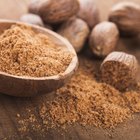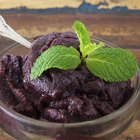
The East Indian spice turmeric and lime juice make a tasty combination in curry and rice dishes, but can also be applied topically to speed wound healing and to dry acne. Made into a paste, turmeric and lime have a history as a traditional beautifier. High doses of turmeric can cause indigestion, nausea and diarrhea. Lime essential oil can increase your skin’s sensitivity to light. Use caution and consult your doctor about any alternative therapies.
Features
If you’ve enjoyed curry made with an orange-colored spice blend, you’ve eaten turmeric — a warming, bitter spice with an intense golden color. Turmeric is made from the root of a shrub that’s related to ginger. Its main active ingredient, curcumin, showed anti-cancer, anti-inflammatory and antioxidant qualities in animal studies, but few reliable clinical trials involving humans are available as of 2010, according to the National Center for Complementary and Alternative Medicine. Lime, a popular citrus fruit, is used in Ayurvedic medicine for abdominal pain, weight loss, and as a beauty treatment, says Vaidya Suresh Chaturvedi, Ayurveda practitioner and professor at Bombay University, in his book “All You Wanted to Know About Diet and Health Through Ayurveda.”
Turmeric Traditional Uses
In addition to its use in curry powder, turmeric is a common food coloring and fabric dye. Urinary tract infection, liver disease and jaundice are among its Ayurvedic applications, in addition to its use in treating skin diseases and as a blood purifier, according to Muhammed Majeed, neutraceutical specialist, and Vladimir Badmaev, Tibetan medicine and immunology researcher, co-authors of “Turmeric and the Healing Curcuminoids.” Turmeric boiled with milk and sugar is a traditional Ayurvedic cold remedy.
Lime Traditional Uses
In addition to using lime juice to flavor sparkling water or get an extra kick of vitamin C, try lime essential oil to help with external and internal complaints, advise Light and Bryan Miller, Ayurvedic healers in Sarasota, Florida. Always dilute essential oils — the Millers suggest combining 15 percent lime oil with 85 percent water or carrier oil, such as olive oil, before using it. Apply diluted lime oil directly to cuts as a disinfectant. Don’t use lime oil before sunbathing: it can cause you to burn.
Combined Alternative Uses
Mixing lime juice with turmeric has long been a part of traditional skin treatments in East India. Exact measures are not important — just mix the paste so that it spreads easily over your skin, according to the website Skin Lightening Treatment. Traditionally, turmeric and lime are supposed to help fade freckles and dark spots and make your skin tone more even. Leave it on for 30 minutes and then rinse with water. Turmeric is a powerful yellow dye, however, so don’t be surprised to find that your skin is yellow, even after rinsing. The yellow cast to your skin should fade overnight.
With Other Ingredients
Turmeric, lime and saltpeter or potassium nitrate mixed together are a traditional healing formula for bruises, inflammation and infected cuts, note Majeed and Badmaev. Perhaps the best way to experience the magic of turmeric and lime is in food. The Intolerant Gourmet, a website specializing in allergy friendly cuisine, recommends making a marinade of coconut milk, lime, red onion, ginger, garlic, sugar and turmeric, soaking sweet potato wedges in it, and baking them for 30 minutes in a 375 degree Fahrenheit oven.
Related Articles

Homemade Remedies With Turmeric

Turmeric, Lemon & Honey

The Use of Neem Juice in Skin Care as ...

Nutmeg and Turmeric for Acne Scars

The Benefits of Lemongrass for Skin

Homemade Bleaching Cream

Lemon Essential Oil for Eczema

Burdock Root for Acne

What Are the Benefits of Lemon Juice ...

Jojoba Oil Benefits

Acai Berry & Acne

Vinegar for Eczema

Chamomile Essential Oil Benefits

How Do I Reduce the Dark Skin From My ...

Eucalyptus Oil & Acne

Chamomile & Aloe Skin Care

List of Retinoids

How to Make Purple Hair Dye From Kool ...

What Are the Benefits of Ashwagandha in ...

How to Get Out Pomegranate Juice Stains
References
Photo Credits
David De Lossy/Photodisc/Getty Images